In the autumn of 1910 two institutions of higher learning opened their doors in Fort Worth within seventeen days of each other:
On September 16 Texas Christian University opened its temporary quarters downtown.
On October 3 Southwestern Baptist Theological Seminary opened its campus just south of town.
To secure these two institutions Fort Worth had employed a simple three-pronged business strategy:
1. Donate land on which an institution can build its campus.
2. Pass the hat among residents to raise any bonus money that an institution demands to relocate.
3. Tiptoe into Waco and scoop up any institution that isn’t nailed to the ground.
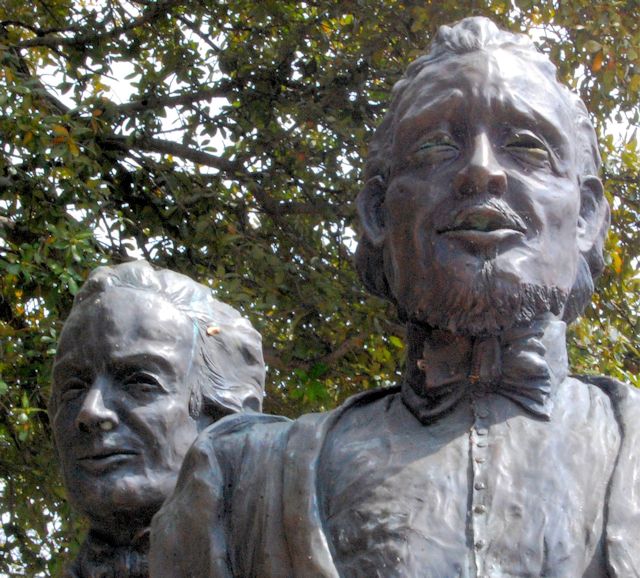
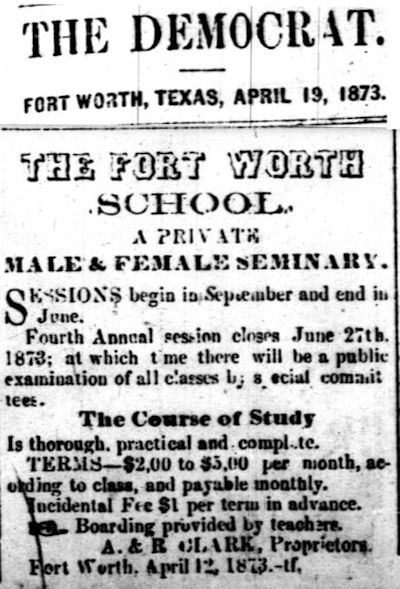 Some bushwhack back story: Brothers Addison and Randolph Clark were minister-teachers who in 1869 established the Fort Worth School, a “private male & female seminary.”
Some bushwhack back story: Brothers Addison and Randolph Clark were minister-teachers who in 1869 established the Fort Worth School, a “private male & female seminary.”
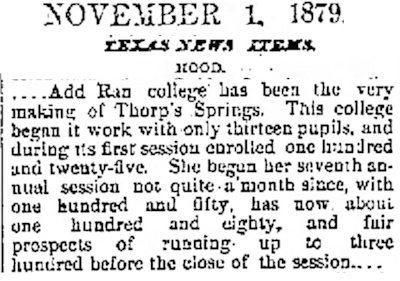 In 1873, to escape the rowdy ambiance of Cowtown, the Clarks moved to Thorp Spring in Hood County and opened AddRan Male and Female College, one of the first coed institutions west of the Mississippi River. The original enrollment was thirteen students.
In 1873, to escape the rowdy ambiance of Cowtown, the Clarks moved to Thorp Spring in Hood County and opened AddRan Male and Female College, one of the first coed institutions west of the Mississippi River. The original enrollment was thirteen students.
 The AddRan college building shortly after it was completed in 1877. (Photo from University of Texas at Arlington Libraries W. D. Smith Commercial Photography Collection.)
The AddRan college building shortly after it was completed in 1877. (Photo from University of Texas at Arlington Libraries W. D. Smith Commercial Photography Collection.)
 Fast-forward to 1895. AddRan College prospered and sought a new home. In 1895 it was given the campus of the defunct Waco Female College. Note that now AddRan was “sustained” by the Christian Church (Disciples of Christ) denomination.
Fast-forward to 1895. AddRan College prospered and sought a new home. In 1895 it was given the campus of the defunct Waco Female College. Note that now AddRan was “sustained” by the Christian Church (Disciples of Christ) denomination.
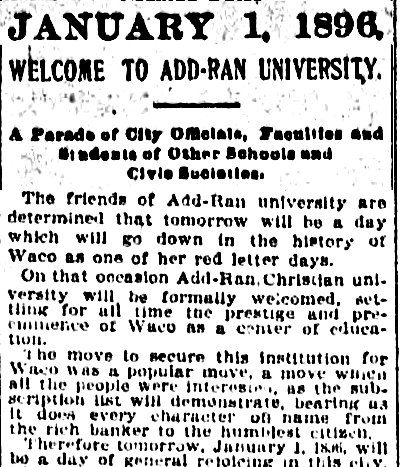
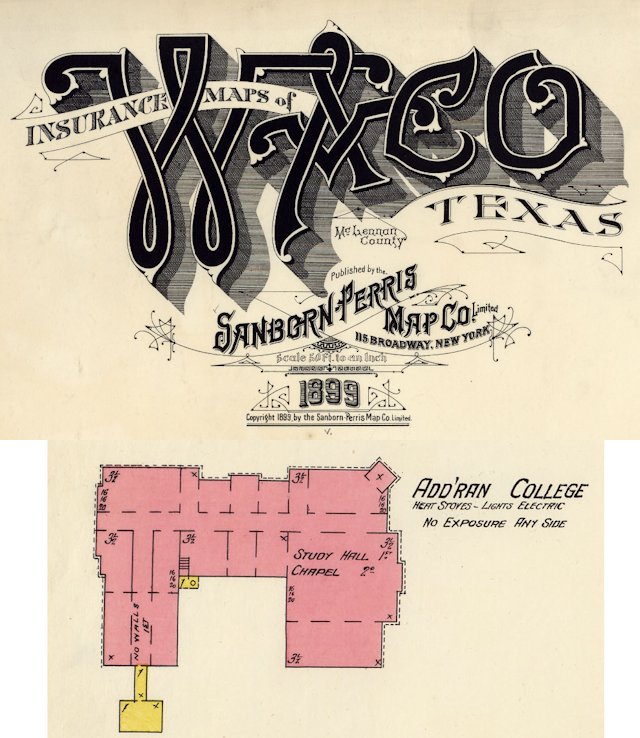 AddRan opened in Waco on January 1, 1896.
AddRan opened in Waco on January 1, 1896.
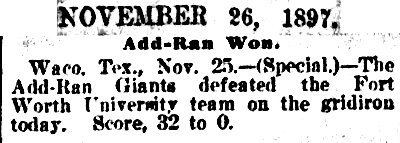 Later that year the school began competing in intercollegiate football, and in 1897 the school’s first yearbook was named The Horned Frog after the indigenous lizard. The horned frog became the school mascot, and students selected school colors: “purple for royalty, white for a clean game.”
Later that year the school began competing in intercollegiate football, and in 1897 the school’s first yearbook was named The Horned Frog after the indigenous lizard. The horned frog became the school mascot, and students selected school colors: “purple for royalty, white for a clean game.”
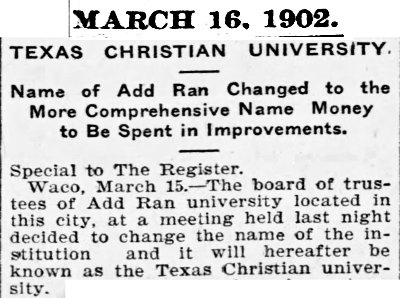 In 1902 the school, to reflect its religious affiliation, changed its name to “Texas Christian University.”
In 1902 the school, to reflect its religious affiliation, changed its name to “Texas Christian University.”
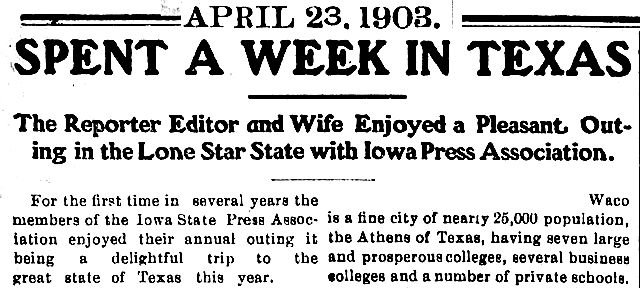 By 1903 Waco called itself the “Athens of Texas” because of its institutions of higher learning.
By 1903 Waco called itself the “Athens of Texas” because of its institutions of higher learning.
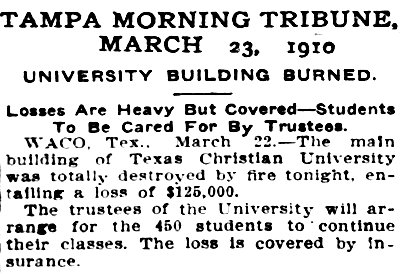 But in 1910 fire destroyed one of those institutions. TCU’s main building burned. Only a gutted shell remained. After the fire, TCU trustees were determined to rebuild and stay in Athens-on-the-Brazos, and civic leaders hoped that TCU would stay if only because Waco had eight churches of the Christian Church denomination.
But in 1910 fire destroyed one of those institutions. TCU’s main building burned. Only a gutted shell remained. After the fire, TCU trustees were determined to rebuild and stay in Athens-on-the-Brazos, and civic leaders hoped that TCU would stay if only because Waco had eight churches of the Christian Church denomination.
But soon other cities sent emissaries—their collars starched, their ’staches waxed—to Waco to whisper sweet somethings in TCU’s ear.
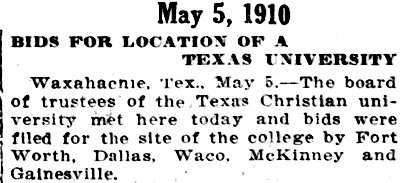 Among those cities were Fort Worth, Dallas, McKinney, and Gainesville. Waco, faced with these brash interlopers, was forced to woo its own university.
Among those cities were Fort Worth, Dallas, McKinney, and Gainesville. Waco, faced with these brash interlopers, was forced to woo its own university.
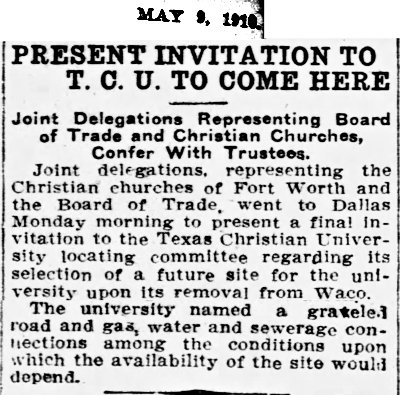 Fort Worth was a most ardent suitor. Delegations of the Fort Worth board of trade (chamber of commerce) and local churches of the Christian Church denomination made their honeyed proposition to TCU’s locating committee.
Fort Worth was a most ardent suitor. Delegations of the Fort Worth board of trade (chamber of commerce) and local churches of the Christian Church denomination made their honeyed proposition to TCU’s locating committee.
TCU listened and stipulated that the site chosen for the campus must be accessible by a graveled road and have gas, water, and sewer service.
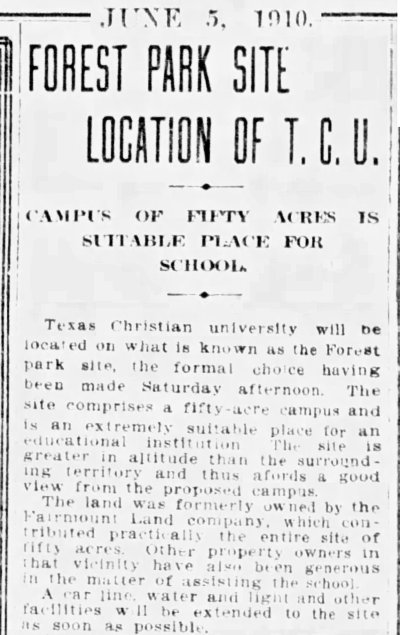 No problem. Fort Worth offered TCU fifty acres south of Forest Park. The Fairmount Land Company donated most of the land, valued at $100,000. Streetcar service and water, electric, and sewer service would be provided.
No problem. Fort Worth offered TCU fifty acres south of Forest Park. The Fairmount Land Company donated most of the land, valued at $100,000. Streetcar service and water, electric, and sewer service would be provided.
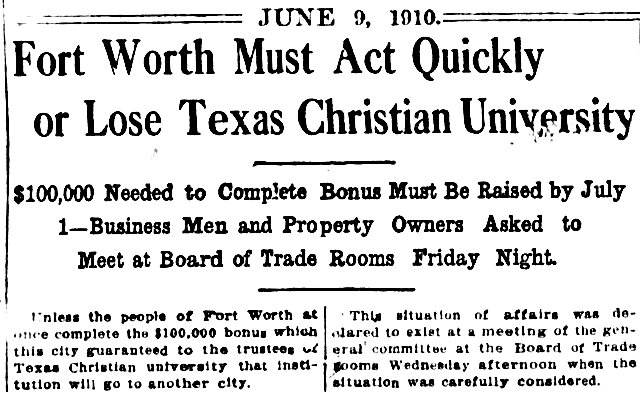 But TCU, aware of how badly Fort Worth and other cities yearned for it, demanded more: a $100,000 ($2.8 million today) bonus.
But TCU, aware of how badly Fort Worth and other cities yearned for it, demanded more: a $100,000 ($2.8 million today) bonus.
Fort Worth didn’t flinch. In the past it had passed the hat to raise similar amounts to lure railroads and the packing plants to town.
But on June 9 the Fort Worth Record warned that Fort Worth was in danger of losing the university if Fort Worth failed to raise the $100,000 by July 1. Dallas, smelling blood, had told TCU that Dallas would top Fort Worth’s offer of $100,000. If Fort Worth failed to raise $100,000, TCU would hie itself hither to Dallas.
 To raise the money, a free “grand concert” was held at Byers Opera House.
To raise the money, a free “grand concert” was held at Byers Opera House.
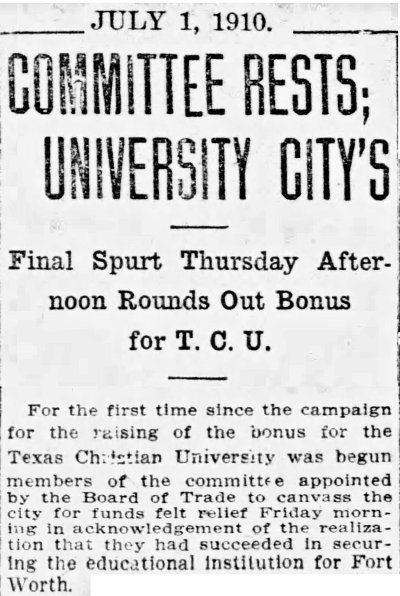 Sure enough, Fort Worth raised the $100,000, half of it donated by churches of the Christian Church denomination.
Sure enough, Fort Worth raised the $100,000, half of it donated by churches of the Christian Church denomination.
So. Fort Worth had met TCU’s demands of a campus site and $100,000. It was now July 1910. TCU’s autumn term normally began in September—just two months away. TCU’s main building in Waco was a gutted shell, and TCU’s campus in Fort Worth could not possibly be ready before autumn 1911.
What to do?
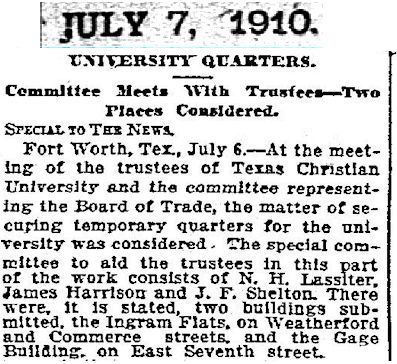
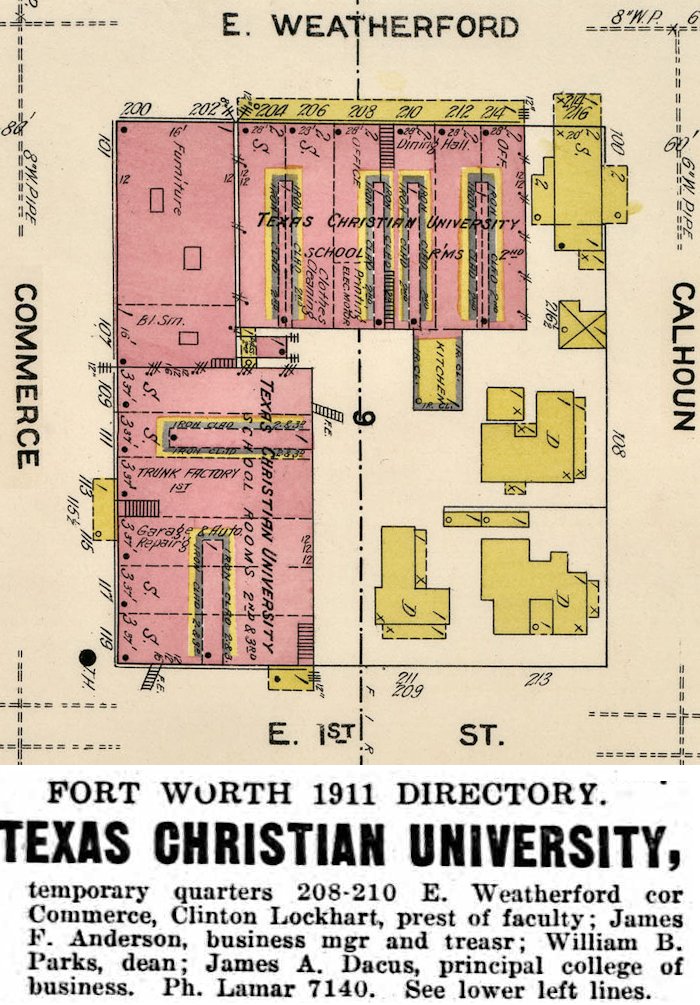 TCU established a temporary “campus” in two buildings on Commerce and Weatherford streets downtown.
TCU established a temporary “campus” in two buildings on Commerce and Weatherford streets downtown.
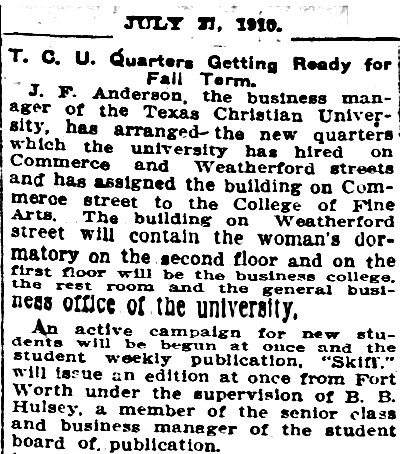 The college of fine arts occupied the Commerce Street building. The Weatherford Street building housed a women’s dormitory, business college, and general business office.
The college of fine arts occupied the Commerce Street building. The Weatherford Street building housed a women’s dormitory, business college, and general business office.
The university was able even to publish its student newspaper, The Skiff.
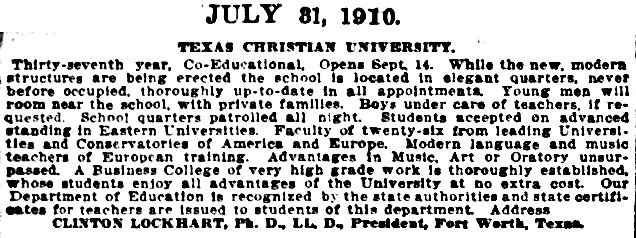 “While the new, modern structures are being erected the school is located in elegant quarters, never before occupied, thoroughly up-to-date in all appointments. Young men will room near the school, with private families. Boys under care of teachers, if requested. School quarters patrolled all night. Students accepted on advanced standing in Eastern Universities. Faculty of twenty-six from leading Universities and Conservatories of America and Europe.”
“While the new, modern structures are being erected the school is located in elegant quarters, never before occupied, thoroughly up-to-date in all appointments. Young men will room near the school, with private families. Boys under care of teachers, if requested. School quarters patrolled all night. Students accepted on advanced standing in Eastern Universities. Faculty of twenty-six from leading Universities and Conservatories of America and Europe.”
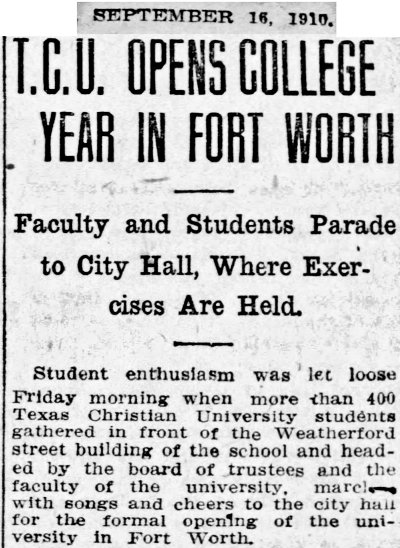 Classes in the temporary quarters began on September 16, 1910. (Classes on the permanent campus would begin a year later.)
Classes in the temporary quarters began on September 16, 1910. (Classes on the permanent campus would begin a year later.)
Down on the Brazos River, a chill autumn wind whistled through the fire-gutted shell of TCU’s main building.
Seventeen days later Waco received another blow: On October 3, 1910 Southwestern Baptist Theological Seminary opened, completing its relocation from Waco to Fort Worth.





